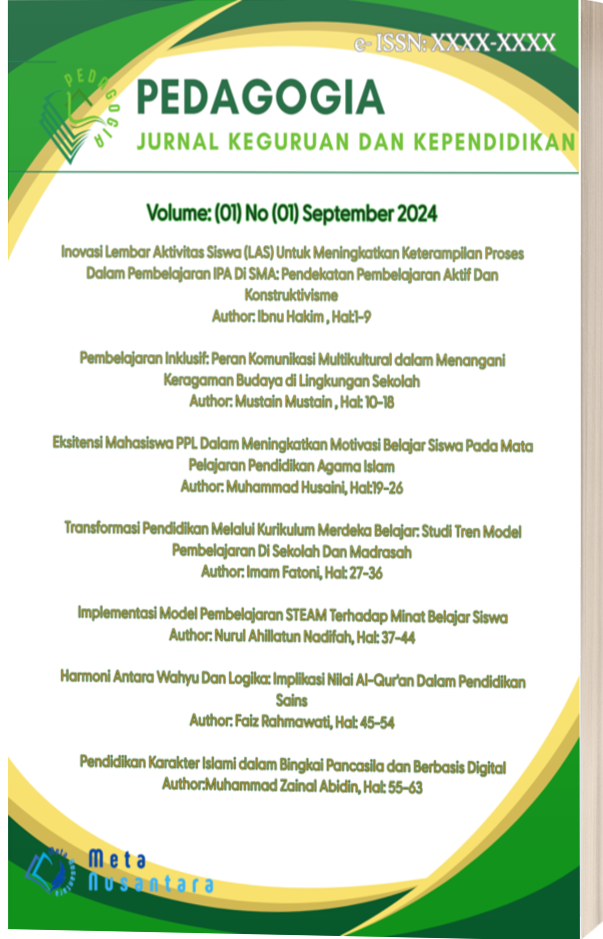Implementasi Model Pembelajaran STEAM Terhadap Minat Belajar Siswa
DOI:
https://doi.org/10.010125/dsvnqk76Keywords:
STEAM Learning, Student Learning Interest, Interdisciplinary Education, Project-Based Learning, 21st Century Skills.Abstract
21st century education demands innovative learning models that can increase students' interest in learning. The STEAM (Science, Technology, Engineering, Arts, Mathematics) learning model comes as an interdisciplinary approach that integrates various fields of science to create a more contextualised and applicable learning experience. This research aims to find out the implementation of the STEAM learning model in increasing students' interest in learning at the primary and secondary school levels. This research uses a descriptive qualitative approach with data collection techniques through participatory observation, in-depth interviews, and documentation studies. The research informants consisted of teachers and students in schools that have implemented STEAM-based learning. The results showed that STEAM implementation increased students' interest in learning by creating a more active, collaborative and problem-solving-based learning environment. Students showed increased intrinsic motivation, engagement in scientific exploration, and critical and creative thinking skills. In addition, this study also found that the main challenges in STEAM implementation are teacher readiness, limited facilities, and the need for a more comprehensive evaluation system.
Downloads
References
Anwar, A., Sariman, S., & Muchlisin, I. (2024). PROFIL PELAJAR PANCASILA INTEGRASI DENGAN PENDIDIKAN AGAMA ISLAM. Al Fattah Ejournal Sma Al Muhammad Cepu, 4(01), 125–138.
Hidayati, A., & Andriani, R. (2022). Implementasi Pendekatan Pembelajaran STEAM Berbasis Model PJBL untuk Meningkatkan Minat dan Hasil Belajar Siswa pada Mata Pelajaran IPAS. Adisa Publisher.
Wijayanti, L., & Kusuma, R. (2021). Implementasi Model Pembelajaran STEAM pada Pendidikan Anak Usia Dini melalui Pembelajaran Daring. Journal Unesa.
Suryani, P., & Prabowo, W. (2020). Implementasi Model Pembelajaran STEAM (Science, Technology, Engineering, Art, and Mathematics): Strategi Peningkatan Kecakapan Abad 21. Jurnal Syntax Admiration.
Haryono, E., Suprihatiningsih, S., Septian, D., Widodo, J., Ashar, A., & Sariman, S. (2024). New Paradigma Metode Penelitian Kepustakaan (Library Research) di Perguruan Tinggi. An-Nuur, 14(1).
Haryono Eko Rangkuti Rizki Kurniawan, Sariman, S. S. (2024). Metodologi Penelitian Kualitatif dan Kuantitatif . Https://Www.Rcipress.Rcipublisher.Org/Index.Php/Rcipress/Catalog/Book/949. Perkumpulan Rumah Cemerlang Indonesia.
Piaget, J. (1972). The Psychology of the Child. Basic Books.
Sholihah, M., & Lastariwati, B. (2020). Implementasi Problem-Based Learning dalam Pendidikan Dasar dan Menengah. Jurnal Pendidikan Sains Indonesia, 8(2), 110-125.
Sari, I. N., & Putra, D. I. (2021). Implementasi Model Pembelajaran STEAM dalam Meningkatkan Minat Belajar dan Kemampuan Berpikir Kritis Siswa SD. Jurnal Ilmiah Citra Bakti.
Siemens, G. (2005). Connectivism: A Learning Theory for the Digital Age. International Journal of Instructional Technology and Distance Learning, 2(1), 3-10.
Sariman, S., Haryono, E., Wahyudin, M., & Muttaqin, F. Z. (2024). Exploring Research Methodologies Qualitative In Higher Education: Strategies And Approaches For Academic Inquiry. Al Fattah Ejournal Sma Al Muhammad Cepu, 4(01), 74–103. Retrieved from https://www.ejournal.smaamc.sch.id/index.php/belajar/article/view/43
Wulandari, N., & Surya, E. (2020). Implementasi Model Pembelajaran STEAM Terhadap Minat Belajar Siswa pada Mata Pelajaran IPA Kelas V SD Inpres 14 Kabupaten Sorong. Eprints Unimuda Sorong.
Downloads
Published
Issue
Section
License
Copyright (c) 2025 JURNAL KEGURUAN DAN PENDIDIKAN

This work is licensed under a Creative Commons Attribution 4.0 International License.






